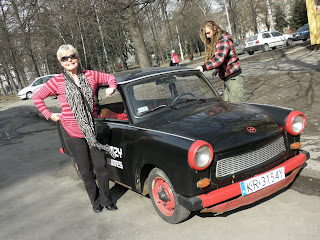
On the second day of our visit to Krakow there were two groups with very different plans. Micky, Sue and Christine were going to visit Auschwitz but as we had been before Kim and I chose Mike’s Crazy Communist Tour instead. We had seen this on a Michael Palin travel programme and it looked like fun so we were keen to give it a try.
We were all a bit surprised that Christine wanted to go to Auschwitz because when we had visited Seville the previous year she refused to visit a bull ring because animals had been killed there but she didn’t mind visiting a Nazi concentration camp where over a million and a half people were abused, tortured and murdered.
After an early breakfast the Auschwitz group set off in their taxi and with an hour to spare before our trip we walked around the streets of Kazimierz, through buildings that were little more than empty shells with rapidly deteriorating structures, through the grounds of a grand church and into the main square that used to be even more important than the market square in Krakow itself. Without a street map we inevitably became confused and slightly lost and only made it back just in time for our scheduled nine-thirty pick up.
The feature of the tour is that the transport is in an original ‘communist’ Trabant car with the promise of a ‘crazy’ driver and sure enough outside our hotel was the vehicle and the driver who presented himself as Eric and who immediately introduced us to the features of the car.
The Trabant (which in medieval German was a foot soldier or personal guard) was an automobile that was produced in former East Germany and was the most common vehicle in that country but was also exported to neighbours inside the communist bloc and sometimes even to the west. It was called the People’s Car and was so popular, and production was so inefficient, that it could take up to fifteen years to deliver after placing the order. The main selling point was that it had room for four adults and luggage in a compact, light and durable shell, which western critics mocked and suggested was made of cardboard but was in fact a sort of fibreglass/plastic.
There were four principal variants of the Trabant, ours was the 601 Station Wagon model, hand painted in black with socialist red trim and finishes. Eric explained that the engine was a small 600cc two-stroke power unit with only two cylinders which gave the vehicle a modest performance with a top speed of seventy miles per hour and zero to sixty taking twenty-one seconds at full throttle. There were two main problems with the engine, the smoky exhaust and the pollution because the car was responsible for producing nine times the amount of hydrocarbons and five times the carbon monoxide emissions of the average modern European car.
Eric explained that the car had no fuel gauge so even though there was a small reserve tank getting to a destination could be a bit of a guessing game and require an element of luck. Because there was no fuel pump in the car the petrol tank was placed high up in the engine compartment so that fuel could be fed directly to the carburetor by gravity. As the engine does not have an oil injection system two-stroke oil has to be added to the fuel tank every time it is filled up, which I imagine is a bit of a chore. This all sounded rather dangerous to me because you have to open the bonnet to refuel and after a run to the petrol station it would be almost certain that the engine will be hot so I imagine it takes a great deal of concentration and Indiana Jones type nerves of steel to visit the filling station!
Keeping a car like this roadworthy probably requires divine intervention but once on board Eric effortlessly negotiated his way out of Kazimierz and towards the main road that would take us to our destination, the communist model new town of Nowa Huta, to the east of Krakow. Inside, the car was basic with rudimentary controls and dashboard. The four speed gear box was operated by a column mounted gear change which looked quite tricky to me but Eric seemed to know his way around the gears well enough and he guided us effortlessly through the early morning traffic. One of the problems he pointed out was that other drivers didn’t often show a lot of respect to the little Trabant and this sometimes made progress slow and difficult.
I was moderately relaxed even though I knew that if the inefficient drum brakes ever failed and there was an accident that my legs were effectively the crumple zone and just a few centimetres in front of my face was the fragile little petrol tank ready to burst into flames and there was a couple of occasions when I found myself operating an imaginary footbrake and Kim admitted later that she was doing the same.
It took about twenty minutes to drive to our destination and in between dodging the gaping potholes and keeping an eye out for discourteous fellow road users, in preparation for the tour and over the clatter of the engine and the creaking of the chassis, Eric kept up an informative narrative about the history of communism in Poland. It was great fun especially as we rattled over tramlines and Eric fought with the steering controls to negotiate some tight bends but eventually we arrived at our destination, left the car and began our visit to Nowa Huta.



No comments:
Post a Comment